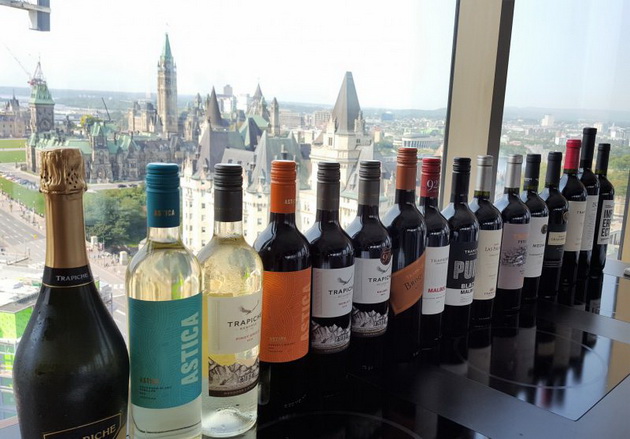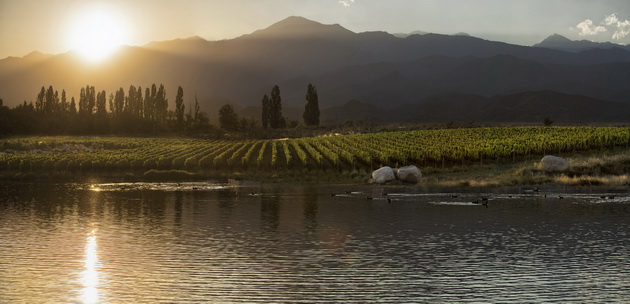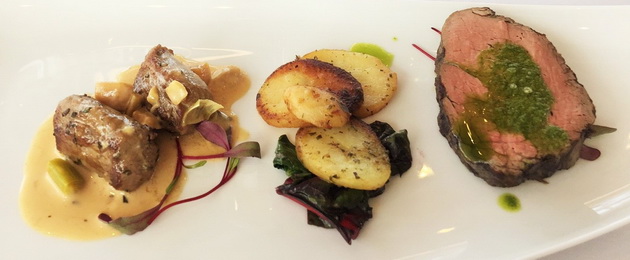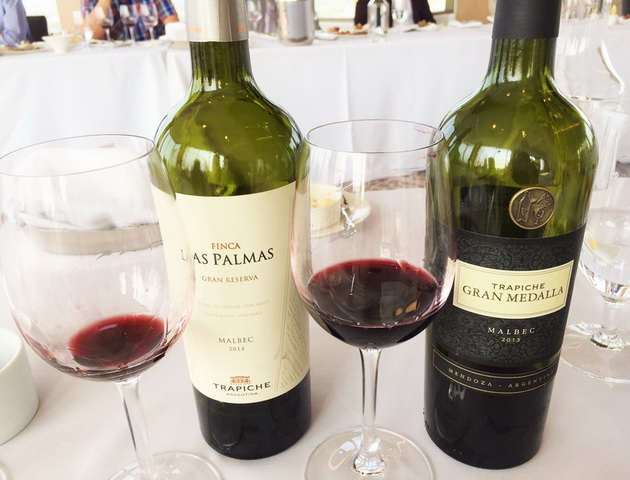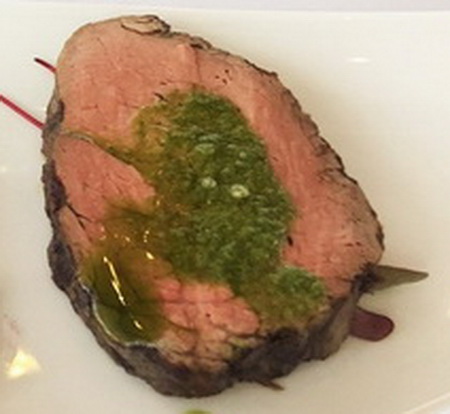Recently, Canada’s top wine writers and sommeliers gathered in the nation’s capital for a portfolio tasting with Sergio Case, head winemaker with Trapiche Winery in Argentina.
Not only did he take us through a spectacular lineup of upcoming releases, but the event was also hosted at Ottawa’s newest event space, the glass-encased ballroom in the sky on the 22nd floor of the Westin Hotel.
It’s a 3,200 square foot ballroom with a 270 degree view of downtown Ottawa, the Parliament buildings, the Ottawa River, and the Gatineau Hills, with the leaves starting to turn colour.
You can watch the entire live stream video of this event on Facebook here.
Jennifer MacDonald Havers
Wine Columnist, Ottawa Citizen
It was a beautiful late summer day, with a view overlooking Canada’s Parliament. Our group had the pleasure of a great lunch and informative tasting of the portfolio of Trapiche wines from Argentina, led by the winemaker, Sergio Case.
This winery has a lot of history – founded way back in 1883. We heard a bit of the history of the vineyard and then dove into their extensive profile, of course highlighted by several types of Argentina’s signature grape, Malbec.
Many of Argentina’s vineyards are landlocked due to the Andes mountains, which is kind of unique. Much of the land under vine is at high altitude, exposing them to lots of sun, as well as temperature moderating breezes and cool nights, which help to keep grapes from ripening too quickly.
The climate itself is dry, with some areas receiving less than 200 mm of rain per year. Irrigation, therefore, is essential and different techniques are used depending on the grapes grown and the soil composition.
Malbec is obviously the star and thrives in Argentina, but we learned that Argentinians are embracing wines made from blends as well. (Hopefully we might see some of these come to Canada!).
One grape they are using more to blend with Malbec is Cabernet Franc which seems to grow well in the vineyards and drier conditions, and it provides some pure fruit flavours and smoothness to complement the robust Malbec grape.
Tasting across a range of different Malbec was so interesting, as both winemaking techniques as well as the effect of different soils become more evident. The winemaker used different maceration times to enhance fruit character and extract more colour in the grape.
We also saw the vibrancy and pureness of Malbec that has not seen any oak aging. I was impressed by the range of styles. No two Malbecs are the same!
What is consistent, however, is the way these wines perfectly complement the Argentinian cuisine. Start experimenting with your chimmichuri recipe and pick up some Trapiche Malbec for your next BBQ.
Andrea Shapiro
Accredited Sommelier
When I arrived at the glass-encased ballroom in the sky, Venue TwentyTwo at Ottawa’s Westin Hotel, I was greeted by a view that would set the tone for the day’s event.
On this bright day, full of sunshine to illuminate the large and expanding room atop the city enclosed in glass and offering a clear view of the Parliament Buildings, Ottawa River and downtown core – one would have a tough time imagining a better location in which to taste wine.
The city, of course, was not the only treasured item that I would view through glass this day. The Argentinian winery Trapiche (pronounced tra-peach-ay) best known for their world-class Malbec wines, had sent us some of their very best bottles; and more impressively, had sent their preeminent winemaker, Sergio Case to educate us on their products.
Sergio introduced himself and explained some of Trapiche’s history and early beginnings. Founded in 1883 this is the oldest winery in Argentina. With the export market booming, Trapiche wines are available in over 80 countries worldwide.
Sergio has been working in the winemaking industry for 18 yrs. He’s a 4th generation winemaker, studied in college and went on to pursue his working experience in Languedoc region in the south of France, before returning to Argentina and joining Trapiche.
Also included in this introduction was Trapiche’s Corporate Business Manager, Juan Ignacio Torre who was also part of the panel. He was engaging and effective at describing and explaining some of the day to day operations, amongst aspects of the business including when new releases will be made available in our market. A bright and entertaining fellow with a jovial sense of humour. He kept us informed, educated and smiling!
We enjoyed an ample and intricate lunch and food accompaniments to the wine led by award-winning Executive Chef Kenton Leier. This included an assorted plate of cheeses and charcuterie featured from locally sourced artisan food shop, Seed to Sausage. https://seedtosausage.ca/
The white wines were an intro into the days’ tasting, beginning the honour with Trapiche’s Extra Brut NV Sparkler. They started making sparkling wine ten years ago and now this is very popular on the export market.
A blend of 70% Chardonnay, 20% Semillon, and 10% Malbec, made using the Charmat Luongo method, with 30-35 days fermentation and then on the lees for 3 months more. Notes of pear, green apple, citrus and faint yeasty brioche elements really brightened this up. Light bodied with medium-fine bubbles, the celebration was truly in the glass.
Lively and refreshing.
Next, it was on to the reds! Some of the standout and mentionable wines from the day’s tasting included: Broquel, Malbec 2015. This is one the oldest lines and vines from Traphiche.
Broquel means, “family shield”, this is to pay homage to all the ancestral heritage that brought with them the art of wine-making. This fruit forward Malbec is aged in new French oak barrels for 14 – 15 months and has very silky tannins.
Affordable and quite accessible from the LCBO $15.00. It is meant specially to complement a delicious meal. Flavours of black cherry, plum and cranberry influenced puckering acidity is rounded by a fuller medium plus finish. It complemented the roasted yellow and candy cane beet and carrot salad with fennel and basil oil. These two made an intrinsic match.
An intriguing wine worth mentioning was the Astica Merlot/Malbec 2017. This was not on our pre-selected tasting menu, but rather added later and it was certainly worth it.
The Astica line here feature grapes grown from select vineyards in the Cuyo region. They’re hand harvested, and featured in a controlled fermentation process over 14 days with pneumatic pressing.
There is also a slow malolactic ferment in barrel. This brings vivid flavours of blueberry yogurt into this fresh, creamy and fruity wine. Lots of red plums and berries, very juicy and delectable.
During the sampling I kept seeing the delightful set of mixed berries on the cheese plate in front of me and I kept thinking that somehow all of these flavours are completely reflected perfectly in this wine, and of course they coupled beautifully together! This is an outstanding price value featured at the LCBO for $8.00.
Another interesting set of wines came from the PURE series. These wines are aged entirely without oak. We compared them side by side for a horizontal tasting.
The Pure Malbec 2016 vintage was quite surprising. Deep plum, prune, dried fruit, and spicy notes one would expect to find in a barrel aged wine, were present here. I kept quaffing to appreciate these aromas of cinnamon, nutmeg and a touch of vanilla.
The other featured Pure line Malbec is called Pure Black Malbec 2015. These flavours are richer, more condensed and fuller than its partner.
Predominate notes of “black” fruit flourish and come alive in this one. Black cherry, black plum and dark chocolate with succulent rich tannins.
They are named the “Pure” line because they are the purest reflection of the Malbec grapes. They truly reflect their terroir and don’t hide behind any oak, simply expressing all the complexity that naturally exists with this proud Argentine varietal due to the care and consideration taken during the fermentation process.
They’re bright, layered, juicy and “purely” pleasant!
Not only has Trapiche mastered the secret of winemaking with the Malbec grape, another unexpected and pleasant substantial discovery was the Medalla Cabernet Sauvignon 2013. Medalla has a small shaped mini-medal on the front of the label.
This is to represent “celebration” and let me tell you, does this ever ring true here. It’s a festivity in a glass to say the least for this fine-tuned Cabernet Sauvignon.
They grow in over 45-year-old vineyards in Crus de Piedra in the Maipú region of Mendoza. This had rich dark fruit, elements of red pepper jelly and a hint of jalapeno spiciness in the finish.
The spice and smoky notes in this wine paired perfectly with the Blank Angus tenderloin medallions with chimichurri rub, which truly married well with the fine herbal and earthy elements also found in the wine. Superbly vital to each other, a true gold medal wine and unity, after it’s namesake.
This will also pair well with red meat dishes, barbecue steak, hamburgers and spicy slow cooked ribs.
One of the most interesting stories we learned about a wine is that of Fincas Las Palmas, which means Palm trees. These vines are planted in sandy soils and it’s to commemorate that this is an oasis in the middle of the desert.
The wine, 2014 vintage, is from a few select vineyards in the San Carlos region of the Uco Valley and planted at 1050 meters. Fantastic medium purple colour with purple reflections and an ever-evolving bouquet of ripe blackberry, blueberry, cherry and a hint of smoked meat, with a balsamic note in the palate.
Really very full and rounded with rich tannins and keen acidity. You can almost feel the refreshing breeze of the Oasis and hear the Palm trees swaying with the bright full and fruity freshness. Decadent and delicious. Available in Vintages 186668 $16.95
My personal favourite wine of the day was also the last one we tried. Imperfecto Malbec 2012 vintage. This started as the winemaker directors garage – Daniel Pi’s, pet project to tinker with.
Imperfecto gets its name from the 3% addition of Cabernet Franc to this blend, thereby making it an “imperfect” Malbec. It presently ferments in a large concrete, egg-shaped wine tank, in the garage, with only a limited number of bottles made and ages in French oak barrels.
This has an unbelievable colour, deep, dark and inky with deep purple reflections in the glass with luxurious notes of blackcurrant, plums, leather, floral violets and smoky cedar. It finishes full, dry, delicious, decadent and imperfectly perfect.
This was enjoyed thoroughly with Dark Valrhona chocolate mousse with praline and macerated berries. The blueberries even by themselves were an outstanding accompaniment. And the dark chocolate elements in the mousse fit perfectly to complement the same notes in the wine.
Saved the best for last! Eagerly awaiting its arrival in our market at the end of October, Vintages release.
Through some of these revolutionary winemaking practices, Trapiche has grown into Argentina’s leading exporter of fine wines with the Reserve Malbec, being a top seller worldwide, leading the way. The real adventure of the day’s tasting belonged to the red wines.
We took a journey into the world of Malbec, the country’s prized and flagship varietal and seen many layered versions of the terroir in which it was grown accenting the different wine-making and aging styles and just how expressive each wine truly was. This was the time for this flagship varietal to speak, and did it ever – through the eyes and mouths of Trapiche.
We ventured into the world of Malbec, while not it’s original French birthplace – Argentina is now its home and Trapiche, their guardian.
Trapiche Fincas Las Palmas Malbec 2014
Uco Valley, Mendoza, Argentina
Caitlin Coleman
Accredited Sommelier
Stepping out of the elevator onto the 22nd floor of the Westin Hotel was nothing but sheer delight as I took in the panoramic views of Parliament Hill and the Ottawa River in the Capital City.
Appropriately named TwentyTwo, this new banquet hall was an excellent start to an educational, cultural and mouth watering afternoon with Trapiche Wines.
Trapiche Wines began growing grapes in 1883 in Maipo, Argentina, one of the first to create a planting zone in Mendoza and is the longest standing winery to this day. This is where the grapes for the first fine wines from Argentina were grown.
Our tasting was hosted by Sergio Case, winemaker; and Juan Torre, the Canadian business manager for Trapiche. They described many of the wines we tasted as coming from the Uco Valley.
The Valle de Uco is a stunning viticultural region southwest of Mendoza and is considered one of the top wine regions in Argentina. What I found the most interesting was the different soils they are planting their grapes in and the effect it has on the flavour of the wines.
The terroir is really reflective on the flavour profiles of each wine, ranging from different forms of alluvial soil, to big rocky soils and silty clay soils. The vineyards are irrigated using melted ice from the Andes mountains, the purest form of water and nutrients to be found.
Along with the high elevation and plenty of sunlight, all of these elements combined can create wines that are highly concentrated and dark in colour with a wealth of flavour.
We tasted 16 different wines that ranged from cheerful, easy drinking and affordable, to huge, robust and iconic. What a lucky lady I am!
Malbec was obviously the star of the afternoon as it is the flagship grape varietal of Argentina, however, we also tasted some surprisingly impressive Cabernet Franc, Cabernet Sauvignon, Merlot and a sparkling extra brut.
I would have to say my favourite wine of the day was the Iscay (LCBO SKU#450585 $49.95) Malbec (65%) and Cabernet Franc (35%). This wine was like two dark grapes in combat! Smoky red fruits from the Malbec, violets, green and black notes from the Cab Franc on the nose.
Juicy concentration on the palate. There was finesse, structure, ripeness, spice and an intriguing nose, versus palate contrast that changed my whole perspective on these two varietals. Yum!!!
Juan and Sergio explained that the Latin culture loves to celebrate and are passionate about what they do. I can honestly say that these words are true and expressed beautifully through the wines we tasted together.
Award-winning the Executive Chef is prepared a wonderful food matching menu for us:
– Charcuterie and artisan Quebec cheeses with seed to sausage deli meats Featuring duck prosciutto, bresaola, chorizo and Calabrese
– Rustic dark greens salad with cured heirloom tomatoes &
– Roasted yellow and candy cane beet and carrot salad Fennel and micro dill crostini
– Chef action station Blank Angus tenderloin medallions with chimichurri rub, prepared in twenty two
– Lamb tenderloin with porcini mushroom fricassée Lyonnaise potatoes cooked in duck fat
– Dark Valrhona chocolate mousse with praline and macerated berries in individual glasses
Trapiche Gran Medalla Malbec 2013
Mendoza, Argentina
Greg Hughes
Wine Writer & Sommelier
One of Argentina’s oldest commercial wineries, Trapiche, doesn’t really need any introduction. They are one of the most prominent Argentinian producers on the market.
For many of us, they were the introduction to Argentine wine when we first kindled our interest in wine.
It was gratifying to see a winery of this prominence to be able to show a select group of people, gathered on floor Twenty-Two of the Westin Ottawa, the focus and direction they have set themselves for growth and development.
Based in Mendoza, in the west of Argentina (near the Andes), this winery was part of the main crest of the Malbec-wave; the surge of consumer popularity that turned an ampelographical curiosity into a staple of every summer barbecue in North America.
We started with something “off-menu.” An ‘extra brut’ sparkling, with chard, semillon, and malbec making up the blend.
Sourced from Agrelo and Uco and done in the charmat style, for freshness. They call the process charmat lungo. Essentially, it has a long fermentation at low temperatures to enhance fresh flavours and aromatics.
There was plenty of Malbec. We happily stained our teeth, while growing to appreciate the different quality tiers they presented us.
Interestingly, however, Trapiche has been developing a growing interest in cultivating Cabernet Franc, as a blending partner for Malbec. As a wine enthusiast from Ontario, I have a particular soft-spot for Cabernet Franc. The wines incorporated it well.
Argentina grows at such high altitudes that they easily capture the aromatic core and freshness of Cab Franc, while giving it more than enough heat and exposure to ripen it consistently. My only regret is not having been able to experience a pure example of Trapiche Cabernet Franc.
One of Sergio Case’s announcements turned out to be one of the most interesting and exciting details of the entire session. Trapiche has begun a new experiment getting away from their continental comfort. They will be starting five hectares of vineyards just six kilometers from the ocean.
It is more humid and the microclimate is vastly different from amy terrain currently recognized within an Argentine appellation. In Mendoza, their challenges were drastic changes in temperature, drought, and over-exposure.
In this new pocket, they’ll be challenging themselves with similar conditions to Prince Edward County or western Niagara. Disease pressure and plant vigour will both be issues in this new area, perhaps. The name of the new venture will be ‘Costa Pampa,” which roughly translates to ‘Coastal Plains.’
Costa Pampa is being planted to Pinot Noir, Chardonnay, Albarino, Sauv Blanc, and Riesling. Maybe more Cab Franc is in order too (this time, in a cooler climactic style).
Sergio also hinted that this new explorative planting could mean they would be poised to manufacture quality traditional method sparklings in this climate as well.
My sincerest thanks to the people of Trapiche for their dedication. Also, thank you to the folks at Philippe Dandurand for offering us the opportunity to learn about a winery of which so many of us only had a surface comprehension.
Trapiche Iscay Malbec Cabernet Franc 2011
Mendoza , Argentina
Jane Staples
Wine Columnist, Ottawa Wedding Magazine
Winelovers know that Malbec comes from Argentina, but who knew that there are so many delicious styles of this varietal? I recently had the opportunity to taste an extensive flight of Trapiche wines with their head winemaker, Sergio Case, with food pairings prepared by Ottawa Westin’s award-winning Executive, Chef Kenton Leier.
Trapiche makes wines for every budget, so that was the first piece of good news. But we were also happy to learn that you don’t have to blow your budget to enjoy luxury Trapiche wines that earn 94 points from Robert Parker, such as the slyly named “Imperfecto,” so named because it has 97% Malbec and 3% Cabernet, the Cabernet making it an imperfect wine.
We kicked off the tasting with Trapiche Extra Brut Sparkling wine, made from an unusual blend of Chardonnay, Semillon and Malbec. Unanimous agreement that this is a terrific sparkling wine and great value too, priced under $15.00.
We tasted several Malbecs, from entry-level, mid-range to luxury styles, such as Iscay and Ambrosia.
A couple of hours later, our tasting team was well-acquainted with over a dozen variations of Mendoza Malbec, as well as Trapiche’s terrific Cab Sauv, Pinot Grigio and sparkling wine. But Trapiche makes many other wine products in addition to those we tasted.
This biodynamic winery is located in Mendoza, at the foot of the Andes, housed in a restored Florentine-style building that is surrounded by olive trees and vineyards. If you’re ever fortunate enough to visit Argentina, a visit to their winery is an absolute must.
Trapiche Terroir Series Finca Ambrosia Single Vineyard Malbec 2013
Mendoza, Argentina
Trapiche Gran Medalla Cabernet Sauvignon 2014
Mendoza, Argentina
Sylvain Segard
Accredited Sommelier
I participated in a great tasting event lead by Sergio Case, the senior winemaker at Trapiche Wines, including a sneak peek of this famous Argentine winery’s 2017 wine release.
Señor Case guided us through 16 different wines by providing detailed information about the vineyards and winemaking practices used to elaborate each wine. My favourite of the series was the Perfiles Calcareous Soil Malbec ($18.95). The grapes selected for this wine were grown in the chalky soils of the Tupungato area in Mendoza at the lofty altitude of 1250 meters.
Of the many Malbecs we sampled that afternoon in the lovely rooftop ballroom of Ottawa’s Westin Hotel overlooking the Parliament buildings and the Gatineau Hills, this wine stood out with its intense plums flavours, vivid acidity, and pronounced minerality. It was quite refined for its price. And, it would definitely be a perfect match with red meats done in your preferred grilling method.
The words ‘great quality at every price point’ would describe the entire flight I tasted. Indeed, I was impressed with the excellent execution of all the wines served.
Whether it was an entry level table wine such as the Astica White ($8.00), a blend of Sauvignon and Semillon Blanc, the general list bottles of Broquel Malbec ($14.95) or of Pure Malbec ($15.95), or the higher end Terroir Series Ambrosia ($39.95) or Imperfecto ($53.95), all the wines expressed the typical markers of their varietals. They were well-balanced and showed a juicy mouthfeel with gentle tannins — making then easy to enjoy on their own and good companions with protein dishes.
Naturally, the higher end cuvées showed more layering of flavours and aromas and I invite you to read my reviews on NatalieMacLean.com as all are worth trying (save perhaps for the Extra Brut Sparkling, a Charmat method bubbly which, in my view, lacked definition and complexity given the rich blend of Chardonnay, Semillon, and Malbec grapes used to make it).
Given such consistency with the 100% Malbecs and Malbec blends, I would venture to say that Trapiche Wines has emerged as synonymous to Malbec, just as Malbec wines in general have become synonymous with Argentina.
However, I also discovered that Trapiche can excel in other blends and varietal wines. For example, the Iscay ($49.95), a blend of Malbec and Cabernet Sauvignon, has a New World wine freshness with the distinct taste signature of the winemaker, with its superb structure, great fruit character, spicy notes of violets, and refined tannins.
Trapiche also makes a very good 100% Cabernet Sauvignon called Medalla Cabernet Sauvignon, which could rival most other New World Cabs.
The winery is not afraid to experiment. Indeed, Trapiche Wines is investing in the development of new vineyards. It is branching out, exploring which grape varietals and which low lying terroirs it can raise on the Atlantic coast, with its humid and cool winds. As the winery experiments how to get best results, we may well see new wines styles emerge out of Argentina in coming years.
I toast to their future success with this exciting endeavour.
Trapiche Perfiles Calcareous Malbec 2015
Mendoza, Argentina
Trapiche Oak Cask Reserve Pinot Grigio 2016
Argentina
Dr. Simon Chen
Sommelier
Today, we welcomed the winemaker of Trapiche winery, Sergio Case, from Argentina, in the beautiful glass-encased ballroom on the 22nd floor of Westin hotel. Trapiche winery was founded in 1883, and it owns over 100 hectares of vineyard in the Mendoza region.
They also source high-quality grapes from other top growers in the country to highlight the versatility of Argentinian wines, which we got to taste in their ‘Terroir Series’ later on. Trapiche Winery produces 10+ series of wines that cover all price points and we had to luxury to try 16 different wines from these series today.
We started off with their NV Extra Brut Sparking wine. In their ‘Sparkling Wine Series’, they produce three wines – Extra Brut, Brut, and Brut Rose. The Extra Brut that we tasted today was made of 70% Chardonnay, 20% Semillion, and 10% Malbec.
They use the Charmat-Martinott method (aka,the tank method) that is often used to produce Prosecco, where the wine gets secondary fermentation in stainless steel tanks. Next, we moved into their ‘Reserve Series’, where we tasted their Pinot Grigio, Malbec, and Merlot. I was mostly impressed with the Pinot Grigio.
They made the wine so it is more toward Pinot Gris-style that has floral and vibrant fruit aromas but on the palate, it’s dry, clean, and has good minerality. At $13 price range, the ‘Reserve Series’ offers really good quality for party wines.
The winemaker also prepared two new series – ‘Astica’ and ‘Pure’ – to let us try what they are currently experimenting. ‘Astica Series’ is their table wine blend. In the red blend, it’s a combination of Merlot and Malbec, whereas in the white blend, it’s a combination of Semillion and Sauvignon Blanc.
I like the white blend more as it is grassy, crisp, medium(+) acidity, yet very approachable. What a quality of $8/bottle XD!!! The ‘Pure Series’ is their new concept of no oak-barrel maturation to display the true characteristics of Argentina’s Malbec.
We then moved to their medium – to higher end series. The ‘Fina las Palmas Series’ is priced at $16-20 but wow, what a good quality wine. It’s big, bold, black fruits and plummy. This is a wine you want to eat with a grilled Argentinian Steak with Chimichurri sauce.
We also tried Cabernet Sauvignon and Malbec from their ‘Medalla Series’ and ‘Gran Medalla Series’, respectively. Sitting at $25 price range, to me, this Cabernet Sauvignon is my WOTD. The cabernet grape is sourced from 45-year old vineyards in the Maipu valley. It’s more refined and less juicy than the Malbec but it still offers the same body, structure, and finish.
Our last three wines were their iconic wines. We first tried the Ambrosia from their ‘Terroir Series’. The grape is sourced from their long-time partner in the Gualtallary wine region. This wine is recommended by the Master of Wine as a standard example for Argentinian Malbecs.
The vineyard is sitting at an altitude of 4,288 feet above sea levels and you can truly taste that this Malbec received less sunlight. It’s less ripe, less fruity, but also more complex on the mid-palate and long lingering tannins due to the cold weather.
The second one we tried is a Malbec and Cabernet Franc blend from the ‘Iscay Series’. Iscay in Incan means Number Two or Duo, and this is why all the wines in this series are blends of two grape varietals. For most of the people, this is their WOTD.
They liked the greenness and acidity from the cabernet franc that bring the extra layer of surprises to the Malbec.
Lastly, we tried the ‘Imperfecto’. This is a garage wine with very limited production that is made by the head winemaker. I gave 93 points to this wine, as it is so perfectly balanced and structured that you would not guess this is a Malbec from a blind tasting.
I would recommend to pair this wine with stews or game meats rather than a big grilled steak.
The food prepared by the head chef at Westin was also amazing and paired really with the wines.
I tried the pinot grio with brie cheese and the pickled plum tomato salad, the Imperfecto and the Cab Sauv from the Medalla Series with the steak with leek/mushroom sauce, and the Malbecs with grilled lamb with chimichurri sauce.
The winemaker also suggested trying Imperfecto with the dark chocolate mousse dessert but since I’m not a big fan of wine with chocolate, I didn’t do it.
Trapiche Reserve Malbec 2015
Mendoza, Argentina
Trapiche Pure Malbec 2016
Mendoza, Argentina
Tania Thomas
Wine Expert, Rogers Daytime Television and Photographer
Trapiche Pure Black Malbec 2015
Mendoza, Argentina
Trapiche Imperfecto Malbec 2012
Mendoza, Argentina
Trapiche Extra Brut Sparkling 2017
Mendoza, Argentina
Trapiche Reserve Malbec 2015
Mendoza, Argentina
Trapiche Broquel Malbec 2015
Mendoza, Argentina
Trapiche Reserve Merlot 2015
Mendoza, Argentina
Trapiche Astica Merlot Malbec 2017
Mendoza, Argentina
 Trapiche Vineyard and Mountains
Trapiche Vineyard and Mountains
Trapiche Astica Sauvignon Semillon 2017
Mendoza, Argentina
Sergio Eduardo Casé is one of Trapiche’s senior winemaker. He began working for the company in 2000 and at the present moment he is responsible for the production of high end wines.
He has been linked to the world of wine since his childhood. This is the fourth generation that enjoys this kind of art and this is reflected in his education which began when he was only 13 years old, obtaining a degree in winemaking 5 years afterwards.
Motivated by his passion for wines, he obtained a degree course in winemaking and fruit and vegetable industry, and a postgraduate course in Quality Planning and Management “From the Vineyard to the Wine”.
His first steps in the winemaking field were by his father’s side, making sparkling wines in a Cooperative winery located in the province of Mendoza.
He had different international experiences in the most prestigious winemaking regions like Pomerol, Bordeaux , Champagne, Chateauneuf du Pape and Languedoc-Roussillon in France; Tuscany in Italy and Napa Valley in the US. He also visited the main oak producer areas in the United States like Missouri and Virginia.
Together with his wife Carolina, he wants to keep the family tradition of incorporating his children to the world of wine. The family ritual consists in visiting the winery each year during harvest time. He enjoys his family and children’s company.
He is an off road and fishing fanatical and his hobbies are the Argentinean cuisine and the good wines.
Argentinian Chimichurri Recipe
Ingredients:
2 cups fresh Italian parsley
4 medium garlic cloves
1/4 cup packed oregano leaves
1/4 cup red wine vinegar
1/2 teaspoon red pepper flakes
1/2 teaspoon coarse salt
Freshly ground black pepper
1 cup extra-virgin olive oil
Instructions:
Place parsley, garlic, oregano, vinegar, red pepper flakes, salt, and pepper in the bowl of a food processor, about 1 minute total.
With the motor running, add oil in a steady stream. Refrigerate at least 2 hours or up to 1 day to allow the flavors to intensify. Before serving, stir and season as needed.
The chimichurri will keep in the refrigerator for up to 1 week.
 Geoffrey Morden, Executive Chef
Geoffrey Morden, Executive Chef
The Westin Ottawa
Executive Chef: 14 years
Fairmont: 18 Years – Chateau Laurie 8 year, Lake Louise 2 Years, Winnipeg for 3 Years, Lake Louise 2 Years, back to Chateau Laurie for 3 years
Shaw Centre: 6.5 years
Having spent 17 years as part of the culinary team of various Fairmont properties, Geoffrey was also part of the opening team of the Shaw Center.
His experiences have helped him develop leadership and culinary skills, through the management of multi-outlet hotels and large volume catering operations.




